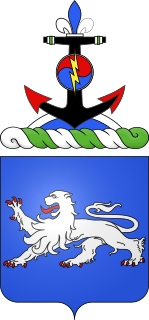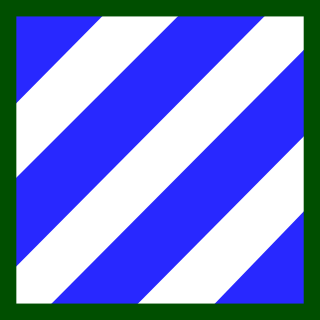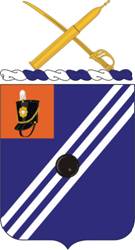
The 24th Infantry Division was an infantry division of the United States Army. It was inactivated in October 1996, it was based at Fort Stewart, Georgia and later reactivated at Fort Riley, Kansas. Formed during World War II from the disbanding Hawaiian Division, the division saw action throughout the Pacific theater, first fighting in New Guinea before landing on the Philippine islands of Leyte and Luzon, driving Japanese forces from them. Following the end of the war, the division participated in occupation duties in Japan, and was the first division to respond at the outbreak of the Korean War. For the first 18 months of the war, the division was heavily engaged on the front lines with North Korean and Chinese forces, suffering over 10,000 casualties. It was withdrawn from the front lines to the reserve force for the remainder of the war after the second battle for Wonju, but returned to Korea for patrol duty at the end of major combat operations.

The 509th Infantry Regiment is an Airborne Infantry regiment of the United States Army. Previously titled the 509th Parachute Infantry Regiment or 509th (PIR), this battalion was activated at fort Benning, Georgia as the 504th Parachute Infantry Battalion in October 1941. Nicknamed "Geronimo", the 509th conducted the U.S. Army's first combat jump during World War II, flying 1,500 miles from England to seize Tafarquay airport in Oran, Algeria on 8 November 1942. In total, the 509th made five combat jumps during the war.
The 12th Cavalry is a cavalry regiment of the United States Army.

The 172nd Infantry Brigade was a light infantry brigade of the United States Army stationed at Fort Wainwright, Alaska and later moved its headquarters to at Grafenwöhr, Germany. An active duty separate brigade, it was part of V Corps and was one of five active-duty, separate, brigade combat teams in the U.S. Army before its most recent inactivation on 31 May 2013.

The 8th Infantry Regiment of the United States, also known as the "Fighting Eagles," is an infantry regiment in the United States Army. The 8th Infantry participated in the Mexican War, American Civil War, Philippine Insurrection, Moro Rebellion, World War I, World War II, Vietnam War, and Iraq Campaign.

The 171st Infantry Brigade was an infantry brigade of the United States Army based at Fort Jackson, South Carolina. With a long history of serving, the brigade saw action during both World War I and World War II before it was inactivated in 1946. During the Cold War the brigade was once again activated for a period of ten years until again inactivated in 1972. In 2007 the brigade was reactivated as a training support unit and inactivated on 10 June 2016.

The 191st Infantry Brigade was constituted on 24 June 1921 in the Organized Reserves as Headquarters and Headquarters Company, 191st Infantry Brigade, and assigned to the 96th Division. It was organized in December 1921 at Portland, Oregon, and redesignated on 23 March 1925 as Headquarters and Headquarters Company, 191st Brigade, then redesignated on 24 August 1936 as Headquarters and Headquarters Company, 191st Infantry Brigade. It was converted and redesignated on 6 April 1942 as the 96th Reconnaissance Troop, 96th Division. The Troop was ordered into active military service on 15 August 1942 and reorganized at Camp Adair, Oregon, as the 96th Cavalry Reconnaissance Troop, an element of the 96th Infantry Division. It was reorganized and redesignated on 16 August 1943 as the 96th Reconnaissance Troop, Mechanized, and then again reorganized and redesignated on 20 November 1945 as the 96th Mechanized Cavalry Reconnaissance Troop. Following World War II service with the 96th Infantry Division in the Pacific, it was inactivated on 3 February 1946 at Camp Anza, California.

The 68th Armor Regiment was first activated in 1933 in the Regular Army as the 68th Infantry Regiment.

The 48th Infantry Brigade Combat Team is a modular infantry brigade of the Georgia Army National Guard. One of the oldest units in U.S. Army history, the lineage of the 48th Infantry Brigade can be traced back to 1825. It is one of few units in the US military that also saw service as a unit of the Confederate States of America during the American Civil War. Today, the 48th IBCT is part of the U.S. Army's "Associated Units" program where it's aligned under the 3rd Infantry Division, a combined arms combat maneuver unit of the Regular Army.
The 64th Armor Regiment is an armor regiment of the United States Army, organized under the United States Army Regimental System. It is descended from the 758th Tank Battalion (Light) that served in the Italian Campaign during World War II. Redesignated as the 64th Tank Battalion, it was assigned to the 3rd Infantry Division during the Korean War and it spent most of the Cold War stationed in West Germany before elements were transferred to Ft. Stewart, Georgia in the late 1990s. The regiment participated in Desert Shield, Desert Storm, Desert Fox, Desert Spring, Operation Iraqi Freedom and Operation Enduring Freedom.
The U.S. 41st Infantry Regiment is a regiment of the United States Army. Its 1st Battalion is currently assigned to the 2nd Infantry Brigade Combat Team, 4th Infantry Division. Its 3rd Battalion is assigned to the 1st Stryker Brigade Combat Team, 1st Armored Division.

The 197th Infantry Brigade is an inactive Infantry brigade of the United States Army. The brigade was active as an Organized Reserve unit from 1921–1942, in the Regular Army from 1962–1991, and as a TRADOC training unit from 2007–2013. The brigade saw service in Operation Desert Storm with the 24th Infantry Division.

The 1st Brigade, 24th Infantry Division was an infantry brigade of the United States Army. Before its most recent deactivation in 2006, it was based at Fort Stewart, Georgia. It was a divisional brigade of the 24th Infantry Division.
The 67th Armored Regiment is an armored regiment in the United States Army first formed in 1929 in the Regular Army as the 67th Infantry Regiment. It first became the 67th Armor in 1940. The regiment participated in World War I, World War II, Desert Storm/Desert Shield, Operation Iraqi Freedom, Operation Enduring Freedom, Operation Spartan Shield, Operation Inherent Resolve, Operation Resolute Support, and Operation Freedom's Sentinel.

The 51st Infantry Regiment is a regiment of the United States Army first established in 1917.

The 3rd Aviation Regiment is a regiment of the United States Army Aviation Branch. It operates the Boeing AH-64 Apache attack helicopter, Sikorsky UH-60 Black Hawk helicopter, and Boeing CH-47 Chinook helicopter. It has been associated with the 3rd Infantry Division for some time.

The 3rd Combat Aviation Brigade is a Combat Aviation Brigade of the United States Army based at Fort Stewart.
The 4th Brigade Combat Team, 4th Infantry Division is an inactive brigade of the United States Army. Between 1975 and 1984, the brigade served at Fort Carson, CO, and in Germany. The brigade was reactivated in 2004, and deployed four times in support of the War on Terror, once to Iraq and three times to Afghanistan, before being inactivated in 2015.

The 103rd Military Intelligence Battalion nicknamed the "Dagger Battalion and the Top of the Rock", was a Combat Electronic Warfare Intelligence (CEWI) battalion assigned to the United States Army's 3rd Infantry Division (Mechanized). The battalion's mission was to "deploy rapidly to a contingency area by air, land, and sea to conduct Intelligence and Electronic Warfare (IEW) operations worldwide."

The 1st Battalion, 76th Field Artillery Regiment is an inactive field artillery battalion of the United States Army. The battalion has been assigned to the 3rd Infantry Division, 7th Infantry Division, 2nd Infantry Brigade, and as a separate field artillery battalion. The battalion has participated in World War I, World War II, Operation Iraqi Freedom, and Operation Enduring Freedom. The battalion inactivated in 2015 as part of Army force reductions.















